#staining bolete
Text



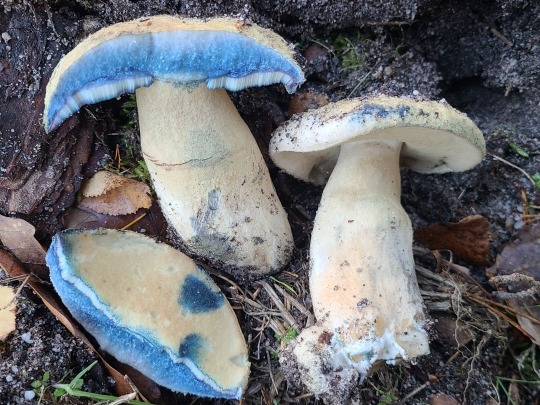



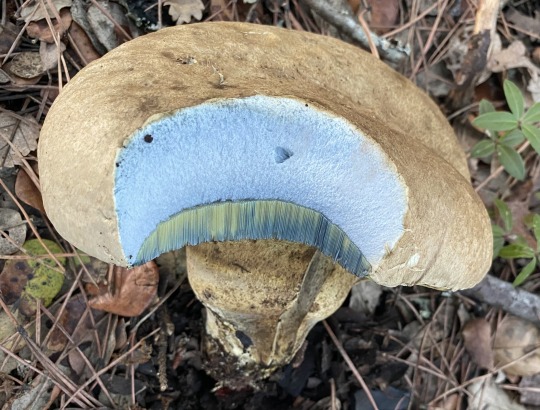

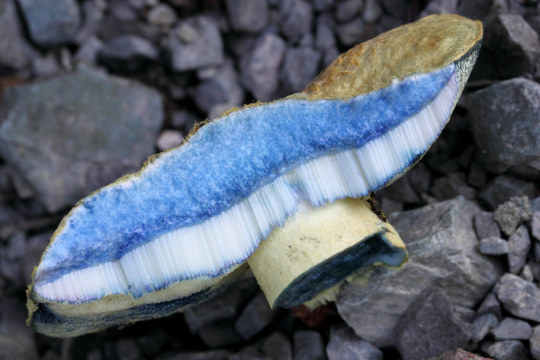
gyroporus cyanescens (cornflower bolete)
#mushrooms#mushroom#fungus#fungi#bolete#cornflower blue#cornflower#cornflower bolete#gyroporus cyanescens#pictures#images#foraging#forage#edible mushroom#foragecore#nature#naturecore#staining bolete#blue#pretty#outdoors#magical
15K notes
·
View notes
Text
#bolete#blueing#blue#staining#bruising#mushroom#fungi#mycology#nature#video#mushrooms#art#inspiration#reference#forest#summer
5 notes
·
View notes
Text

#bad picture i know :(#had to move on quickly#identified#<- blue staining bolete#(Gyroporus cyanescens)#mushroom#mushrooms#mycology#mushroom picture
0 notes
Text
HORROR WEEK- FOTD #144 : apple bolete! (exsudoporus frostii)
the apple bolete (also frost's bolete) is a mycorrhizal fungus in the family boletaceae >:-) it typically grows near the hardwood trees of the eastern US, southern mexico & costa rica.
it was chosen for horror week due to its appearance being reminiscent of muscle tissue !!
the big question : will it kill me??
nope !! however, although they are edible, they are not recommended for consumption as it is quite easy to confuse them with other red boletes. ^^
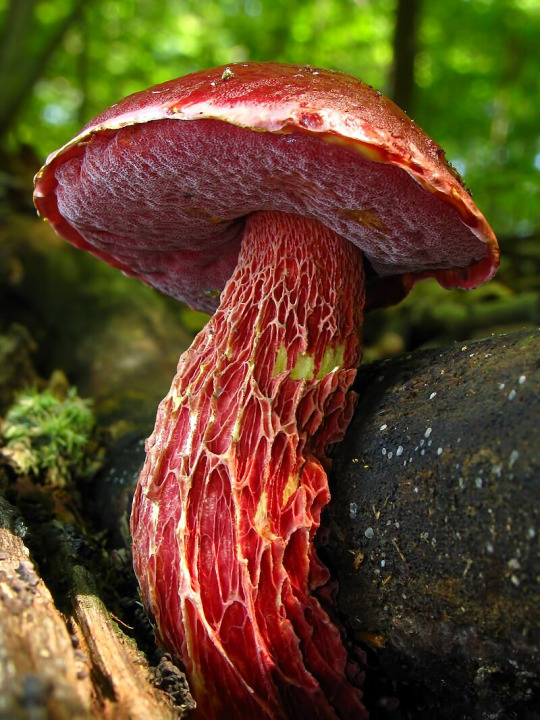
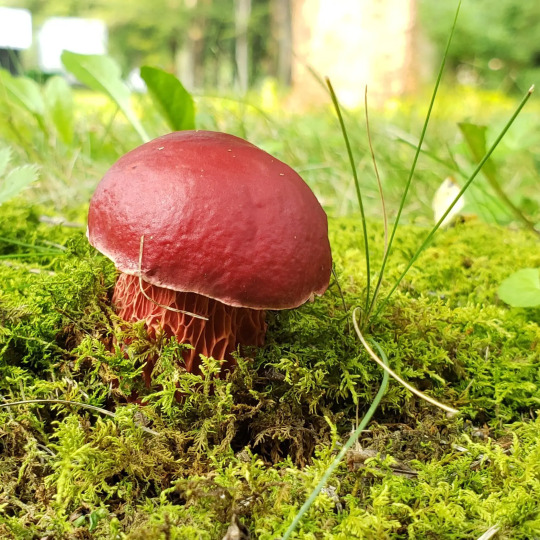
e. frostii description :
"the shape of the cap of the young fruit body ranges from a half sphere to convex, later becoming broadly convex to flat or shallowly depressed, with a diameter of 5–15 cm (2.0–5.9 in). the edge of the cap is curved inward, although as it ages it can uncurl and turn upward. in moist conditions, the cap surface is sticky as a result of its cuticle, which is made of gelatinized hyphae. if the fruit body has dried out after a rain, the cap is especially shiny, sometimes appearing finely areolate (having a pattern of block-like areas similar to cracked, dried mud). young mushrooms have a whitish bloom on the cap surface.
the colour is bright red initially, but fades with age. the flesh is up to 2.5 cm (1.0 in) thick, & ranges in colour from pallid to pale yellow to lemon yellow. the flesh has a variable staining reaction in response to bruising, so some specimens may turn deep blue almost immediately, while others turn blue weakly & slowly.
the tubes comprising the pore surface (the hymenium) are 9–15 mm deep, yellow to olivaceous yellow (mustard yellow), turning dingy blue when bruised. the pores are small (2 to 3 per mm), circular, & until old age a deep red colour that eventually becomes paler. the pore surface is often beaded with yellowish droplets when young (a distinguishing characteristic), & readily stains blue when bruised. the stipe is 4 to 12 cm (1.6 to 4.7 in) long, & 1 to 2.5 cm (0.4 to 1.0 in) thick at its apex. it is roughly equal in thickness throughout its length, though it may taper somewhat toward the top ; some specimens may appear ventricose (swollen in the middle). the stipe surface is mostly red, or yellowish near the base ; it is reticulate — characterized by ridges arranged in the form of a net-like pattern."
[images : source & source]
[fungus description : source]
#• fungus of the day !! •#• horror week >:-) •#[exsudoporus frostii]#: frost's bolete :#: apple bolete :#144#||#image undescribed#fungi#undescribed#mushroom#mushrooms#earth#nature#cottagecore#fungus#foraging#forestcore#mycology#fotd#fungus of the day#exsudoporus frostii#frost's bolete#apple bolete#bolete
234 notes
·
View notes
Text

Blue-staining Bolete sp. and Russula sp. from last winter
143 notes
·
View notes
Text
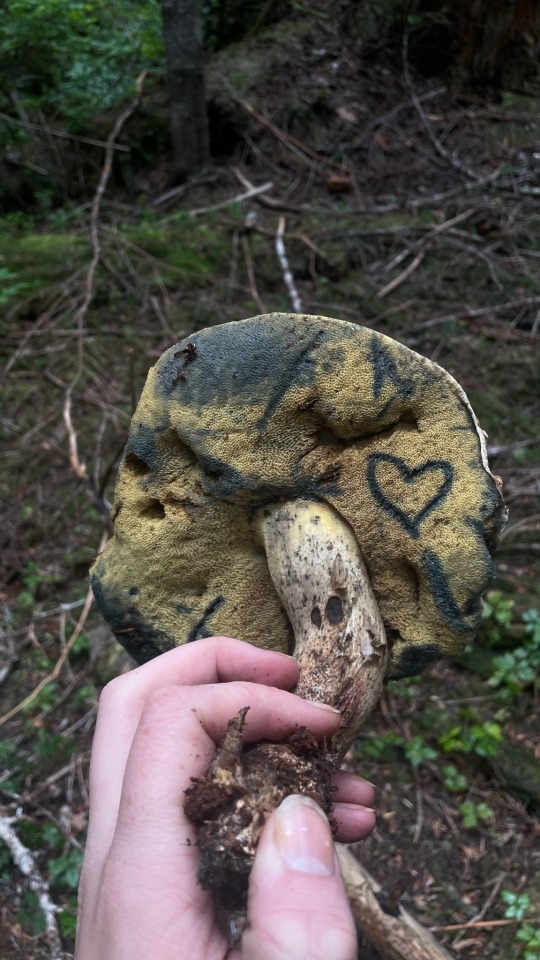

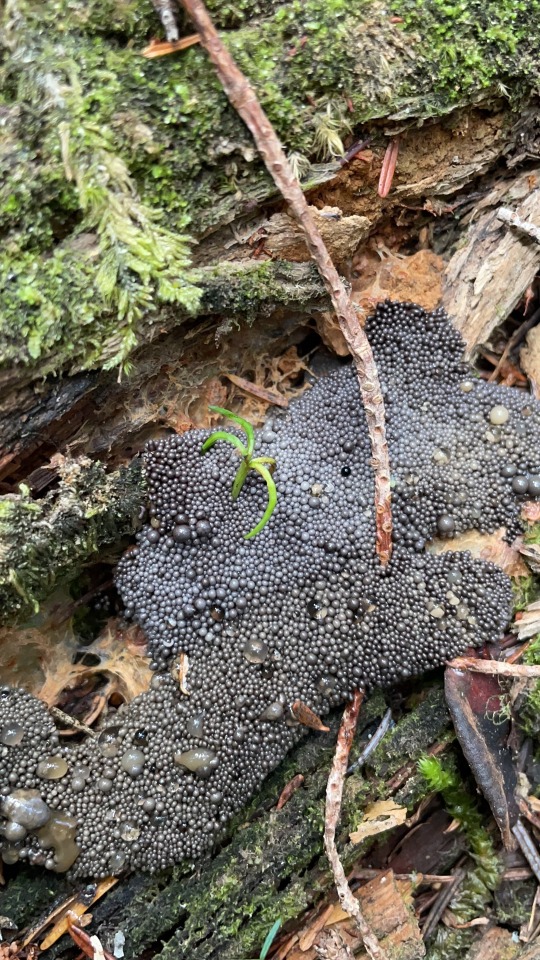

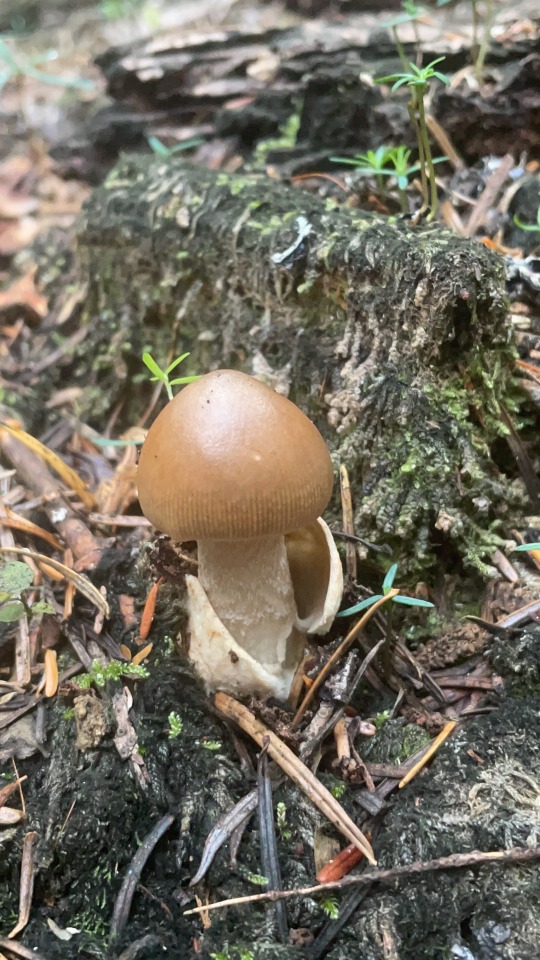
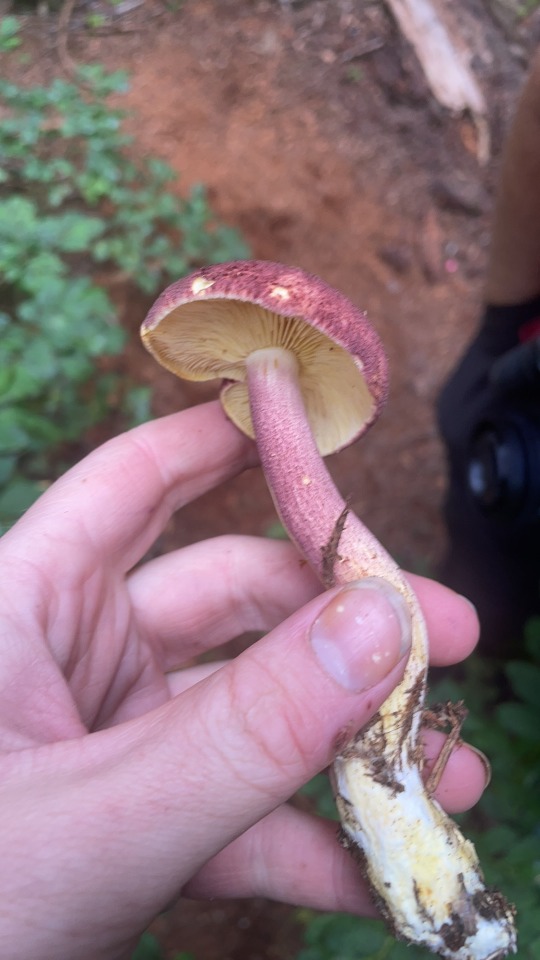


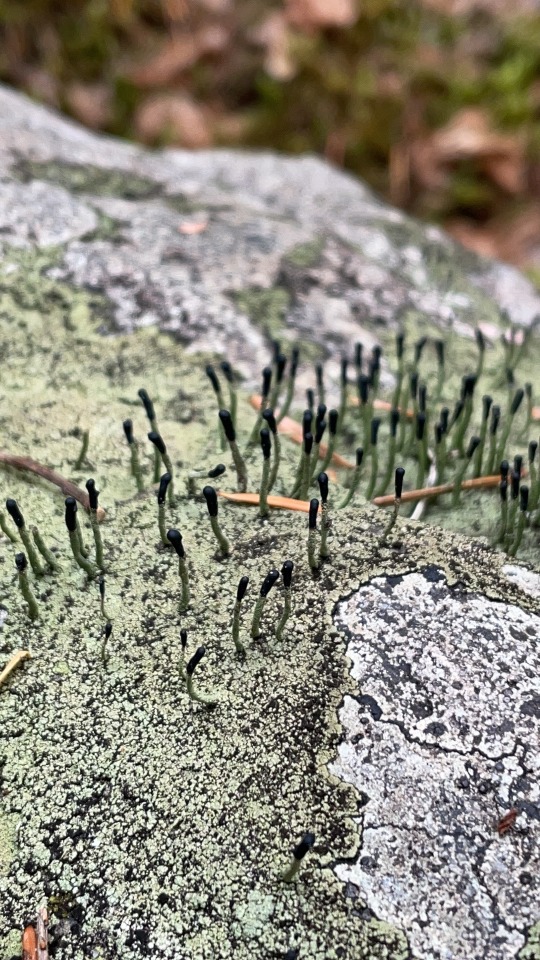

Some photos from yesterday: blue staining bitter bolete (I’ve never seen a mushroom stain that fast!), a giant rock I brought home because it has tapered matchstick lichen on it (former logging area not a national park), slime mold of unknown species, salmon eggs slime mold, western grissette emerging from its egg (possibly, either way I never fuck with amanitas because of how many deadly ones there are and the difficulty IDing them), plums and custard, golden collybia, some white bolete that stained blue, tapered match stick lichen, and a very orange eyelash cup. There were toooons of them but this one was so vibrant
85 notes
·
View notes
Text
So, since the gardening season was unsuccessful, and really sad, I've been dreaming of starting new seeds. I've decided, this time, I'm going to plant so many tomatoes that nothing will be able to prevent the tomato harvest. It's gonna be all tomato garden, 40+ tomato plants, I'll build shelters for them in case of hail, weave nets, I'm ready, let's do this.
However, it's October, and there's precious little I can do in October to start plants; if I germinate anything right now, there won't be enough sun for it to grow, and it will pout and die </3. It happens every year when I stubbornly plant basil and it checks out the daylight levels and decides to nope out of that situation.
So, instead, what I'm doing, is still learning about mushrooms! I'm going to the forest regularly and collecting anything that could possibly be edible, and trying it out. I've been lucky to find so many edible boletes, I've been drying them in the summer and I have a great dried mushroom stash, which will prove very valuable during the winter.
Now there's a mushroom that grows when nothing else is really available, the latin name is 'Neoboletus luridiformis' and it looks like this:

Cool, right? A red bolete mushroom. She's called Scarletina Bolete. Looks poisonous. However, sources claim that this mushroom is edible, granted it's cooked first. I've been sheepish to try it because it's so red, and there are red boletes that are 100% poisonous, so this is just a health risk. You can check if the mushroom is this one because it stains blue and black when you cut it, and mine do. This is how it looks like cut:
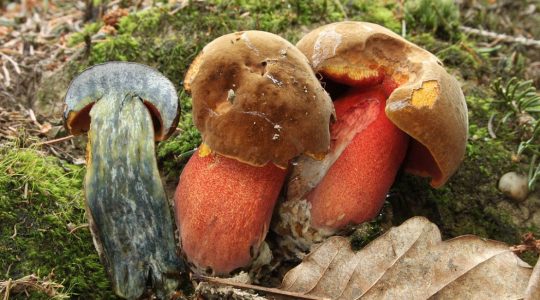
I mean that does look extremely unappetizing but it says right there on wikipedia that it's edible:

hmm so anyway, I've finally decided to stop being a coward, and I cooked the mushroom and had some yesterday! It's still not been a full 24 hours, but I'm faring well for now. If this turns to be a good food source, I'll be set for the entire year because this baby grows at all times in the forest.
Another cool thing I'm trying out is acorn pancakes. I discovered some people on youtube who are making acorn flour and then baking pancakes out of it, and I've been curious about acorns before, but now I'm set with instructions and knowledge on how to process it. Acorns were used as a source of flour before wheat was in use, and it was pretty great, because they didn't need to cut down forests, or plow the fields, or turn bunch of soil to dust; people can just collect acorns because oak trees are everywhere here. The only issue is that the acorns are filled with tannins, which is a chemical that produces a very bitter taste, which makes them not very tasty. However, people have also figured out how to ''wash the tannins out', and there's a process of boiling and throwing water away, or leaving them buried next to a riverbank for a year, in order to get them to taste good.
I haven't yet decided what route I'm going to take, but I collected some acorns last time I was in the forest:
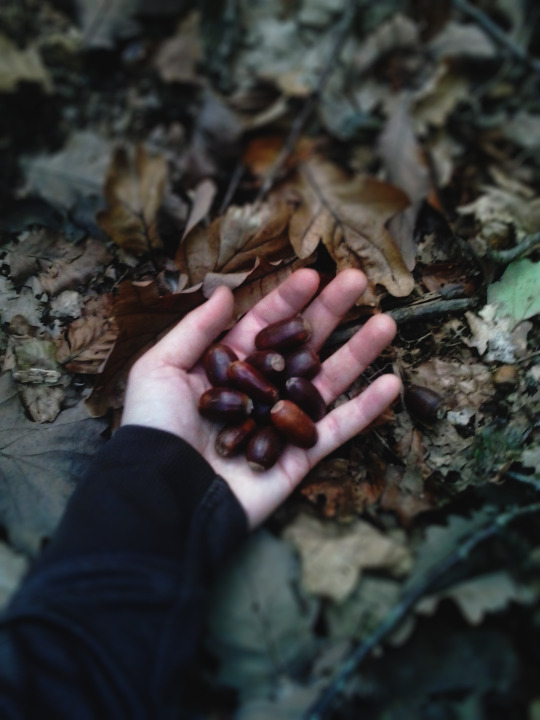
I have to admit they feel very good to hold in hand. They're so nicely brown, almost chestnut in color, they're shiny, pleasant oval shape, and very heavy. It felt like I was holding something valuable, rich. Since they're a wild food, I know they have more nutrients in them than anything we developed ourselves, wild food generally has 3 times more nutrition than anything growing in a human-made garden.
I've also stumbled on a few acorns that have sprouted roots! I've collected them as well, and put them in a soil-filled container on my balcony, let's see if I can grow an oak tree. That would feel extremely cool to grow.
I'm also collecting and curing walnuts (apparently you can make a walnut butter out of them I did not know that), conkers (for the laundry detergent, I love them), nettle (drying into powder, using as a calcium supplement) and I've also found some violets growing at this time, so I collected the leaves for tea; they're medicinal for colds, flus and fevers.
I'm going to the forest again tomorrow, and hopefully I'll write another update about fun things I've found and trying out! Stay safe and don't follow my lead to eat weird things, unless you research them yourself.
#foraging#mushrooms#acorns#acorn flour#gardening#october update#learning about nature#living from the land#foraging for food#processing wild foods#dangerous looking mushrooms#i should make a post from all the mushrooms i've learned to it#it's at least 8 mushrooms by now
40 notes
·
View notes
Text






Boletes - not sure whether it's bicolor bolete or a species of Xerocomus. They stained blue on contact. The first and last one looks like Leccinum rugosiceps
This summer has been strangely awful in terms of mushrooms; we had periods of rain and it wasn't as arid as last year. And yet the typical mushrooms of summer have been virtually nonexistent. There's this guy on IG who I think lives in the French Alps and often posts entire fields of boletes or chanterelles as big as your head, and I always click "like" but my eye is twitching a little and inside I'm writhing with unbecoming, hateful envy. Being a mycophile in the filthier part of New Jersey is hard.
But anyway, last weekend I decided to check out an old haunt in NY state, a place where I used to do a clinical rotation. A cemetery, to be exact (that's where I used to find the mushrooms, I mean; I didn't do my clinical rotation in the cemetery).
Apparently driving a little over 30 minutes and crossing an invisible state line was what did the trick. The place was absolutely teeming with boletes and Amanitas. Not as plentiful as French Alps Guy's bounty, but impressive for the likes of me. Which begs the question, what the fuck is going on with New Jersey? I mean, besides the obvious things
#mycology#fungi#mushrooms#nature photography#dirtcore#goblincore#forestcore#foraging#forest floor#nature#the fungus among us
24 notes
·
View notes
Text



Ink Stain Bolete
#artists on tumblr#original photographers#orofeaiel#pnw#washington#original photography#nikon#nature#hiking#pacific northwest#mushrooms#mycology#mycelium#mycelia#forest#goblincore#naturecore#cottagecore#boletes
13 notes
·
View notes
Text
gender neutral fungi themed names for the modern and tasteful baby: scurfy twiglet, dog stinkhorn, snowy waxcap, white dunce cap, nitrous bonnet, oak loving gymnopus, fawn mushroom, butterfly collybia, deer shield, fragrant funnel, clouded agaric, mica cap, pink edge bonnet, scotch bonnet, brown roll rim, pluteus petasatus, rufous milkcap, armillaria sinapina, red lead roundhead, bleachy entomola, honey fungus, humongous fungus, wood blewit, red stinkhorn, pale brittlestem, camembert brittlestem, russula cerolens, split gill, st. george’s mushroom, meadow waxcap, slender parasol, poison pie, parasola auricoma, earthy inocybe, chocolate milky, stinky squid, tall psathyrella, witch’s hat, grey knight, weeping widow, greville’s bolete, luxury cap, false parasol. Blusher, field blewit, lepista nuda, dead man's foot, banded mottlegill, big sheath mushroom, goblet funnel cap, petticoat mottlegill, grisette, horse mushroom, red edge brittlestem, yellow staining mushroom, springtime amanita, candy cap, wood pinkgill, peach colored fly agaric, scalycaps (pholiota terrestris), liberty cap, milking bonnet, mower’s mushroom, mycena galericulata, pluteus cervinus, nitrous bonnet, salt loving mushroom, firerug inkcap, common puffball, tyromyces chioneus, purple laccaria, panaeolus antillarum, oak bracket, bloody brittlegill, winter russula, penny bun, red chanterelle, lilac bonnet, rosy bonnet, field mushroom, Person
37 notes
·
View notes
Text
Fungi that are on Nurgle's team: ganoderma, chicken of the woods, green stain, honey mushrooms, corn smut, bread mold
Fungi that are NOT on Nurgle's team: indigo lactarius, boletes, russulas, fly agarics, chanterelles
3 notes
·
View notes
Text
#2060 - Cleland’s Gilled Bolete Phylloporus clelandii
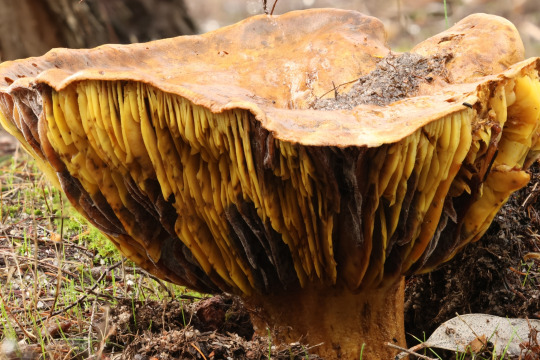
Despite the fact that it looks like a gilled mushroom, this is actually in the Boletaceae. The Bolete Eater Fungus currently eating it certainly wasn't confused.
Almost certainly mycorrhizal with Eucalyptus, but not all of them. Red Gums seem quite popular with the fungus, and it is usually found growing singly or in pairs under the host tree. The 'gills' stain blue-green when bruised, but the colour fades away again.
There are about 50 species in the genus, mostly tropical. Phylloporus arenicola is found in the Pacific Northwest of North America, where it grows in sand dunes in a mycorrhizal association with pine trees.
0 notes
Text
FOTD #132 : shaggy stalked bolete! (aureoboletus betula)
the shaggy stalked bolete is a mushroom-producing fungus in the family boletaceae. it is found across eastern north america (especially in the southern appalachians), where it forms mycorrhizal associations with hardwoods - especially oak. it often grows in
moss :-)
the big question : can i bite it??
yes - this fungus is edible !!


a. betula description :
"cap : 2–5 cm. convex & broadening with age. starts golden yellow discolouring to brownish yellow or reddish orange. texture is sticky & flesh is yellow. pores : 1-2 pores every millimetre with tubes that are 1.5 cm deep. bright yellow turning greenish yellow with age. stem : 10–15 cm tall with a thickness of 1–2 cm. distinctly textured with deep ridges with a slightly swollen & rooting base. stem flesh is white with pink staining when exposed to air."
[images : source & source]
[fungus description : source]
#• fungus of the day !! •#[aureoboletus betula]#: shaggy stalked bolete :#132#||#undescribed#image undescribed#fungus#mushrooms#mycology#mushroom#earth#nature#cottagecore#forestcore#foraging#fungi#fotd#fungus of the day#shaggy stalked bolete#aureoboletus betula
147 notes
·
View notes
Text

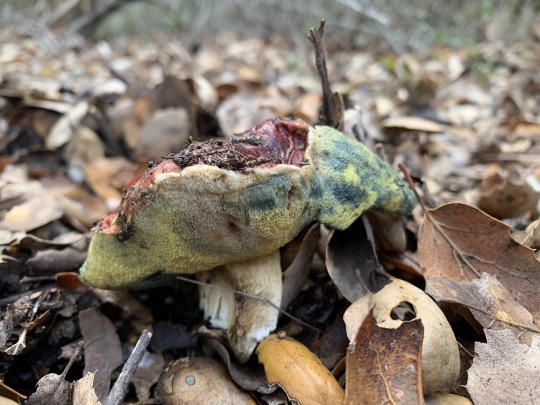
Blue staining bolete from last winter
60 notes
·
View notes
Text

@ouchiis asked: ❛ 𝐈'𝐌 𝐖𝐄𝐋𝐋 - 𝐕𝐄𝐑𝐒𝐄𝐃 𝐄𝐍𝐎𝐔𝐆𝐇 𝐈𝐍 𝐁𝐎𝐓𝐀𝐍𝐘 𝐓𝐎 𝐍𝐎𝐓 𝐅𝐀𝐋𝐋 𝐅𝐎𝐑 𝐒𝐔𝐂𝐇 𝐀 𝐌𝐈𝐒𝐓𝐀𝐊𝐄 , ❜ OUYE began , a bouquet of lilac brown boletes resting in his open palm , softly stained with fresh dirt that clung to the stems of the mushrooms. ❛ yet i know you're equally as versed , if not more than me . . . there's a glint of mischief glowing in your eyes. the mushroom you gave me is stained with blue , a characteristic absent from king boletes naturally harvested . . . the veins appear to be missing from the stem , as well. you gave me a poisonous bolete instead. and yet , i wonder . . . i highly doubt this mix - up was earnest. what were your plans , exactly . . . ? ❜


how cruel would he appear to be if it were in earnest? if he wanted to see what was going to happen? of course he would not leave ouye to struggle for long. jade had after all saved him from drowning once before hadn't he? poisons just worked much differently on the human body, than his own. a shame, there was no way of covering his intentions with ignorance, ouye knew him well enough now. to be aware that jade's fascination with fungus goes beyond simple intrigue. for him, research was merely a step of the process. seeing it all himself, the dangers included, was another. " honestly? nothing terrible. " both hands tucked at his front. " nothing you wouldn't recover from anyway... " spoken with absolute confidence. ouye has come back from worse than a bit of stomach pain.
unprompted / always accepting
#curious? are you sure you want to know? ( answered asks )#ik ur not rlly on ouye rn but...........#100 yrs later
0 notes
Text
One thing I actually hate about academia is how those older articles/papers always tries , consciously and subconsciously, to shit on third world countries.
For example I was reading an article on blue-staining boletes in Yunnan, and of course, of course the author reeked of that classic "white guy on a vacation" superiority complex. Of course. Why did I expect anything different? And of course the article did not give me any new insights into these interesting mushrooms either. Of course. I basically read a couple pages of a white guy observing local people of Yunnan living their lives like he's observing a bunch of animals. An absolutely disgusting waste of my time.
But really? This sort of racism is nothing new. Even my human physiology professor was like this--openly shitting on third world countries in his lectures, and then disguising his racist throries as some sort of "scientific" "educated guess". I'm disgusted all over again just remembering the kind of shit he said.
1 note
·
View note